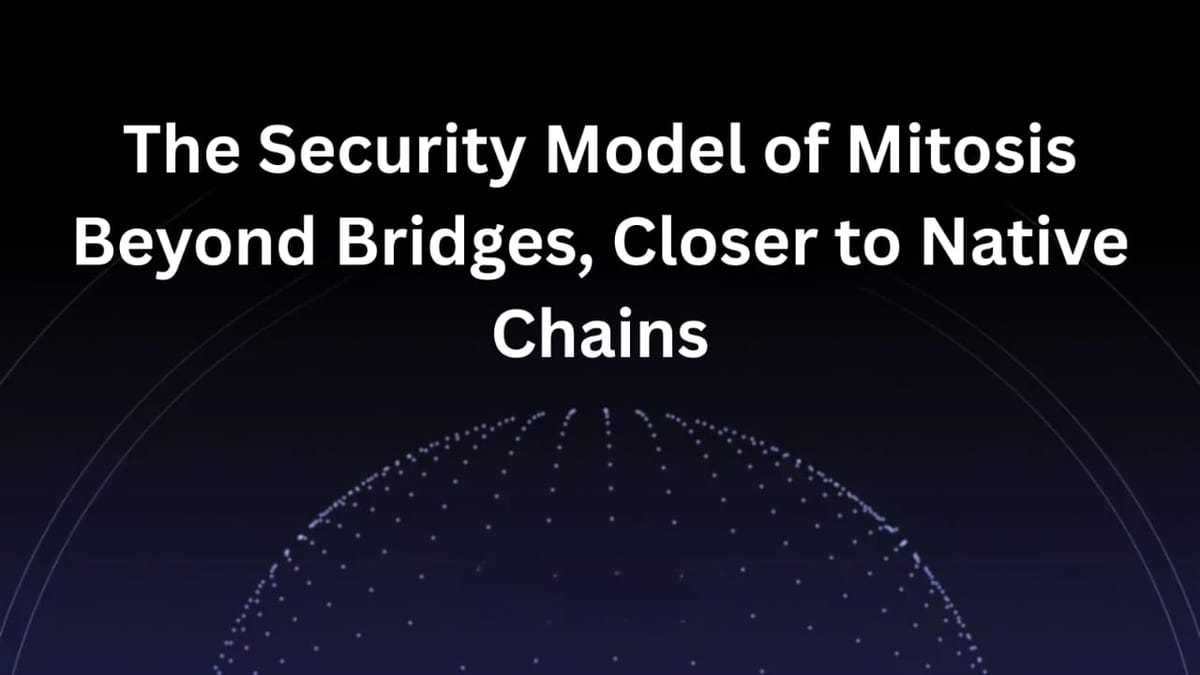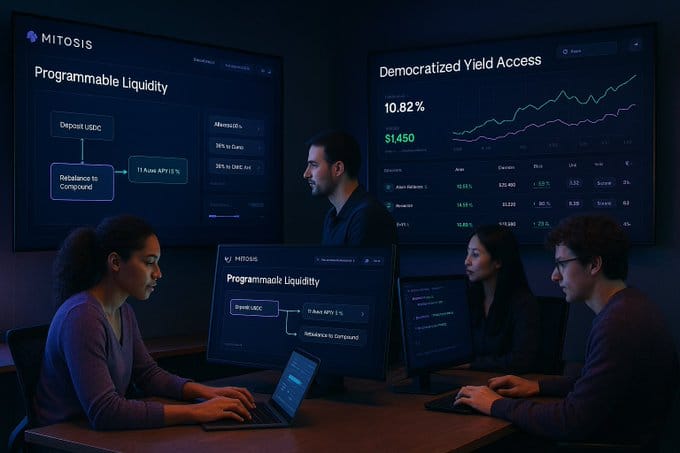The Security Model of Mitosis: Beyond Bridges, Closer to Native Chains

Introduction
In the rapidly evolving landscape of blockchain technology, interoperability has emerged as a critical component for the growth and sustainability of decentralized ecosystems. As protocols strive for seamless interaction across different networks, the security of these interactions becomes paramount. Mitosis, a novel interoperability protocol, aims to provide a secure and efficient means of connecting disparate blockchain networks. This article delves into the security model of Mitosis, comparing it to traditional bridge mechanisms and exploring its unique architecture, validator set, and liquidity pools. We will also discuss future plans to enhance the protocol's security, including audits and the integration of zero-knowledge (zk) modules.
1. Understanding the Security Landscape
1.1. Security Risk Analysis
1.1.1. Bridge Hacks
Bridges have become a popular solution for enabling interoperability between blockchains. However, they are not without their vulnerabilities. The most notable risks associated with bridges include:
- Smart Contract Vulnerabilities: Many bridges rely on smart contracts to facilitate asset transfers. Bugs or exploits in these contracts can lead to significant losses. For instance, the Poly Network hack in 2021 resulted in the theft of over $600 million due to a vulnerability in its smart contract.
- Centralization Risks: Some bridges operate under a centralized model, where a single entity controls the transfer of assets. This centralization creates a single point of failure, making the bridge susceptible to hacks or malicious actions by the controlling entity.
- Liquidity Risks: Bridges often require liquidity to function effectively. If liquidity is drained or manipulated, it can lead to slippage and price discrepancies, undermining the trust in the bridge.
1.1.2 Wrapped Asset Exploits
Wrapped assets, which allow users to hold tokens from one blockchain on another, also present security challenges:
- Trust Assumptions: Users must trust that the wrapped asset is backed 1:1 by the original asset. If the custodian of the wrapped asset is compromised, users may lose their funds.
- Market Manipulation: Wrapped assets can be subject to market manipulation, especially if the underlying asset is illiquid. This can lead to significant price discrepancies and potential losses for users.
- Reentrancy Attacks: Wrapped asset contracts can be vulnerable to reentrancy attacks, where an attacker exploits the contract's state to withdraw funds multiple times before the state is updated.
1.1.3. Trust Assumptions
The security of any interoperability solution hinges on the trust assumptions it requires from its users. Traditional bridges and wrapped assets often necessitate a high degree of trust in third parties, whether they be centralized entities or smart contracts. This reliance on trust can lead to vulnerabilities and exploits, as seen in numerous high-profile hacks.
Mitosis aims to reduce these trust assumptions by leveraging a decentralized architecture and a robust validator set. By minimizing reliance on centralized entities and providing a transparent and verifiable system, Mitosis enhances the security of cross-chain interactions.
2. Mitosis’s Security Architecture
2.1. Validator Set
At the core of Mitosis's security model is its validator set. Validators play a crucial role in maintaining the integrity of the protocol and ensuring secure cross-chain transactions. Here’s how Mitosis’s validator set mitigates risks:
- Decentralization: Mitosis employs a decentralized network of validators, reducing the risk of a single point of failure. This decentralization ensures that no single entity can manipulate the protocol or compromise its security.
- Staking Mechanism: Validators are required to stake a certain amount of the native token to participate in the network. This staking mechanism aligns the interests of validators with the health of the protocol, as they have a financial incentive to act honestly and maintain the network's integrity.
- Consensus Mechanism: Mitosis utilizes a robust consensus mechanism that requires validators to reach a consensus before any cross-chain transaction is executed. This ensures that all validators agree on the state of the network, reducing the likelihood of fraudulent transactions.
- Slashing Conditions: To further incentivize honest behavior, Mitosis implements slashing conditions for validators who act maliciously or fail to fulfill their duties. This means that dishonest validators risk losing their staked tokens, creating a strong deterrent against malicious actions.
2.2. Liquidity Pools
Liquidity is essential for the smooth operation of any interoperability protocol. Mitosis employs a unique approach to liquidity pools that enhances security:
- Decentralized Liquidity Provisioning: Unlike traditional bridges that rely on centralized liquidity providers, Mitosis allows users to contribute to liquidity pools in a decentralized manner. This reduces the risk of liquidity manipulation and enhances the overall security of the protocol.
- Dynamic Liquidity Management: Mitosis employs algorithms to dynamically manage liquidity across its pools. This ensures that liquidity is always available for cross-chain transactions, reducing the risk of slippage and price discrepancies.
- Incentives for Liquidity Providers: Mitosis incentivizes users to provide liquidity by offering rewards in the form of native tokens or fees generated from cross-chain transactions. This reward system encourages a diverse and vibrant pool of liquidity providers, which further decentralizes the protocol’s economic security and resilience.
- Security Through Diversification: By having multiple, distributed liquidity pools rather than a single liquidity source, Mitosis mitigates counterparty and liquidity concentration risks that have plagued many traditional bridges.
2.3. Protocol Architecture
Mitosis’s architecture is designed to minimize attack surfaces and adapt to multiple threat models through the integration of several key components:
- Modular, Composable Design
Mitosis employs a modular structure where components such as validators, liquidity pools, and transaction relayers operate independently but cohesively. This reduces the blast radius of potential vulnerabilities, as any exploit within one module is less likely to cascade through the entire system. - Native Chain Interaction
Unlike wrapped asset bridges that require trust in custodians or proxy contracts, Mitosis focuses on direct interactions closer to native chain protocols. This approach lowers the layers of abstraction and trust required, making it more resistant to classic bridge exploits such as wrapped asset manipulation. - Cross-Chain Messaging and Verification
Mitosis uses secure cross-chain messaging protocols that incorporate cryptographic proofs verified by the validator set. These proofs establish guarantees about state changes and asset transfers, ensuring the legitimacy of cross-chain interactions and reducing the likelihood of fraudulent transactions going unnoticed. - Redundancy and Fail-Safes
To further bolster resilience, Mitosis incorporates redundancies such as fallback verification mechanisms and delayed transaction finality options. These allow users and validators to dispute or revert suspect transactions, adding an additional layer of security against exploits and errors.
3. Comparative Security Analysis: Mitosis vs. Traditional Bridges
Aspect: Trust Model
- Traditional Bridges: Often centralized or semi-centralized
- Mitosis: Decentralized validator set
Aspect: Attack Surface
- Traditional Bridges: Smart contract exploits and wrapped assets
- Mitosis: Modular design with cryptographic proofs
Aspect: Liquidity Provision
- Traditional Bridges: Centralized liquidity pools
- Mitosis: Decentralized, incentivized liquidity pools
Aspect: Asset Custody
- Traditional Bridges: Custodial or wrapped asset model
- Mitosis: Near native chain interactions, no custodians
Aspect: Consensus Mechanism
- Traditional Bridges: Often none or simple
- Mitosis: Validator consensus with slashing
Aspect: Risk Mitigation
- Traditional Bridges: Limited rollback and fail-safes
- Mitosis: Cross-chain verification and dispute systems
Aspect: Audit and Formal Verification
- Traditional Bridges: Varies, often limited
- Mitosis: Planned audits and zk-module integration
Mitosis moves beyond many of the risk factors that have led to repeated bridge hacks by architecting a protocol that is closer in security to native chains rather than traditional bridge models.
4. Future Plans to Harden Mitosis's Security
4.1. Comprehensive Audits
Security audits are foundational to building trust and verifying the integrity of any blockchain protocol. Mitosis has committed to multiple rounds of deep security audits by reputable third-party firms specializing in blockchain technology. These audits will:
- Scrutinize smart contract logic and interactions
- Review validator and consensus mechanism implementations
- Test liquidity pool security and economic incentives
- Identify potential vulnerabilities in cross-chain messaging protocols
Audit findings will be transparently published, and any issues detected will be promptly addressed with patches and upgrades.
4.2. Integration of Zero-Knowledge (ZK) Modules
Zero-knowledge cryptography can transform how cross-chain security is handled by enabling succinct and privacy-preserving proofs of transaction validity. Mitosis plans to integrate zk-rollups and zk-SNARKs (Zero-Knowledge Succinct Non-Interactive Argument of Knowledge) into its architecture to:
- Provide scalable and efficient cross-chain transaction verification
- Reduce trust assumptions by enabling validators to verify proofs without accessing underlying data
- Enhance privacy features for users and liquidity providers
- Minimize attack vectors through cryptographic guarantees rather than reliance on economic incentives alone
The use of zk-modules aligns with Mitosis’s overarching goal to offer a near-native security model while maintaining excellent interoperability performance.
4.3. Continuous Monitoring & Incident Response
Security is an ongoing endeavor. Beyond audits and cryptographic innovations, Mitosis will implement:
- Real-time monitoring systems to detect suspicious activities or anomalies across validator nodes and liquidity pools
- Rapid incident response protocols involving community stakeholders and developers to contain and remediate threats
- User-friendly alert mechanisms to keep users informed about ongoing security and network health
- Regular security drills and simulations to prepare the defense team for emerging threats
This ecosystem-wide approach ensures that Mitosis remains vigilant and responsive in a landscape of evolving blockchain threats.
Conclusion
Mitosis represents a significant advancement in the quest for secure, trustworthy blockchain interoperability. By addressing the key weaknesses of traditional bridges including centralized trust, wrapped asset vulnerabilities, and liquidity concentration risks and combining these with a decentralized validator set, modular architecture, and innovative cryptographic enhancements, it offers a security model that approaches the robustness of native chains.
As cross-chain communication becomes ever more critical to the advancement of decentralized finance, gaming, and Web3 ecosystems, protocols like Mitosis that prioritize rigorous security while enabling seamless interoperability will become foundational building blocks of the blockchain future.
OFFICAL LINKS
- Mitosis University
- Explore Mitosis Now
- Mitosis Documentation blog
- Join the Mitosis Discord Community
- Follow Mitosis on Twitter (X)
Additional Resources
- Mitosis Official Documentation — https://docs.mitosis.io/security
- Poly Network Hack Postmortem — https://poly.network/blog/postmortem
- Understanding Wrapped Assets and Risks — https://www.coindesk.com/learn/what-are-wrapped-bitcoins-wbtc-explained
- Zero-Knowledge Proofs for Blockchain Developers — https://zkp.science/
- Bridge Security Audits (Trail of Bits) — https://blog.trailofbits.com/tag/audits/
- Cross-Chain Messaging Protocols Survey — https://arxiv.org/pdf/2104.08924.pdf
For developers, security researchers, and users wanting to explore interoperability’s frontiers, Mitosis presents an exciting protocol to watch closely.



Comments ()